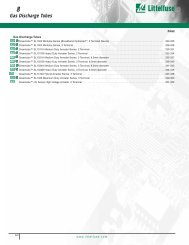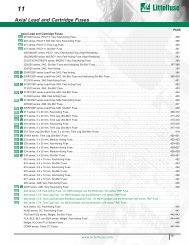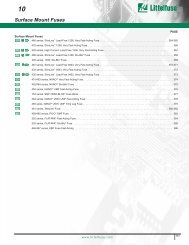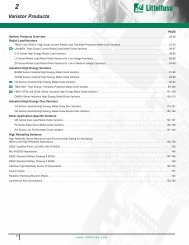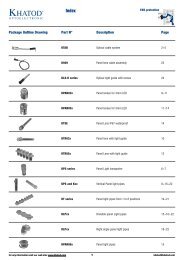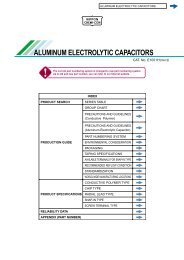TVS Diode Arrays
TVS Diode Arrays
TVS Diode Arrays
Create successful ePaper yourself
Turn your PDF publications into a flip-book with our unique Google optimized e-Paper software.
<strong>TVS</strong> <strong>Diode</strong> <strong>Arrays</strong><br />
Electronic Protection Array for ESD and Overvoltage Protection<br />
SP721<br />
Peak Transient Current Capability of the SP721<br />
The peak transient current capability rises sharply as the width of the<br />
current pulse narrows. Destructive testing was done to fully evaluate the<br />
SP721’s ability to withstand a wide range of peak current pulses vs time.<br />
The circuit used to generate current pulses is shown in Figure 5.<br />
The test circuit of Figure 5 is shown with a positive pulse input. For a<br />
negative pulse input, the (-) current pulse input goes to an SP721 ‘IN’<br />
input pin and the (+) current pulse input goes to the SP721 V- pin. The<br />
V+ to V- supply of the SP721 must be allowed to float. (i.e., It is not tied<br />
to the ground reference of the current pulse generator.) Figure 6 shows<br />
the point of overstress as defined by increased leakage in excess of the<br />
data sheet published limits.<br />
The maximum peak input current capability is dependent on the ambient<br />
temperature, improving as the temperature is reduced. Peak current<br />
curves are shown for ambient temperatures of 25 o C and 105 o C and a 15V<br />
power supply condition. The safe operating range of the transient peak<br />
current should be limited to no more than 75% of the measured overstress<br />
level for any given pulse width as shown in the curves of Figure 6.<br />
Note that adjacent input pins of the SP721 may be paralleled to improve<br />
current (and ESD) capability. The sustained peak current capability is<br />
increased to nearly twice that of a single pin.<br />
PEAK CURRENT (A)<br />
7<br />
6<br />
5<br />
4<br />
3<br />
2<br />
1<br />
T A = 105 o C<br />
T A = 25 o C<br />
www.littelfuse.com<br />
+<br />
VX -<br />
R 1<br />
VOLTAGE<br />
PROBE<br />
R1 ~ 10Ω TYPICAL<br />
VX ADJ. 10V/A TYPICAL<br />
C1 ~ 100µF<br />
(+)<br />
1<br />
2<br />
3<br />
4<br />
VARIABLE TIME DURATION<br />
CURRENT PULSE GENERATOR<br />
CURRENT<br />
SENSE<br />
IN<br />
IN<br />
IN<br />
V-<br />
SP721<br />
FIGURE 5. TYPICAL SP721 PEAK CURRENT TEST CIRCUIT<br />
WITH A VARIABLE PULSE WIDTH INPUT<br />
CAUTION: SAFE OPERATING CONDITIONS LIMIT<br />
THE MAXIMUM PEAK CURRENT FOR A GIVEN<br />
PULSE WIDTH TO BE NO GREATER THAN 75%<br />
OF THE VALUES SHOWN ON EACH CURVE.<br />
V+ TO V- SUPPLY = 15V<br />
0<br />
0.001 0.01 0.1 1<br />
PULSE WIDTH TIME (ms)<br />
10<br />
V+<br />
IN<br />
IN<br />
IN<br />
8<br />
7<br />
6<br />
5<br />
(-)<br />
C1<br />
100 1000<br />
FIGURE 6. SP721 TYPICAL SINGLE PULSE PEAK CURRENT CURVES SHOWING THE MEASURED POINT OF OVERSTRESS IN<br />
AMPERES vs PULSE WIDTH TIME IN MILLISECONDS<br />
+<br />
-<br />
237<br />
5<br />
<strong>TVS</strong> DIODE ARRAYS





